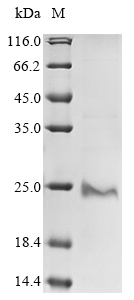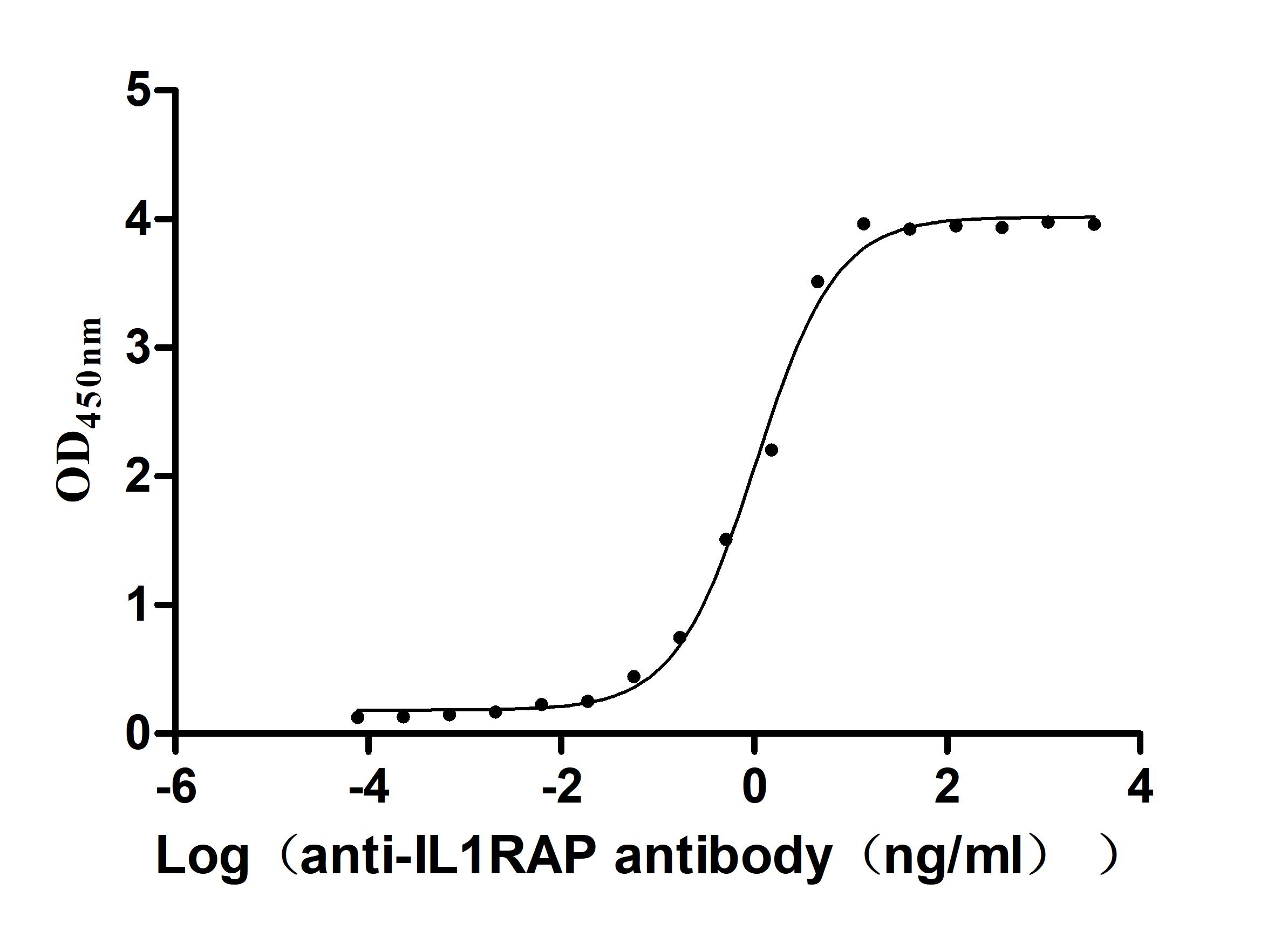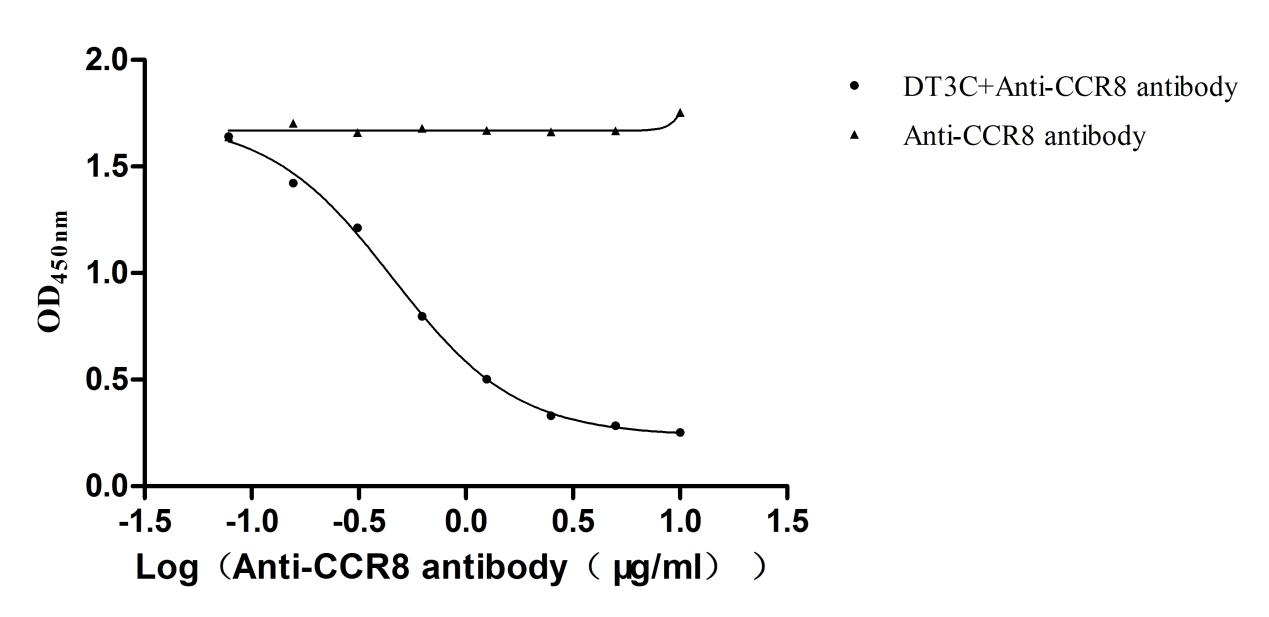Recombinant Human Protein PML (PML), partial
In Stock-
中文名称:人PML重组蛋白
-
货号:CSB-BP018236HU
-
规格:¥3168
-
图片:
-
其他:
产品详情
-
纯度:Greater than 85% as determined by SDS-PAGE.
-
基因名:
-
Uniprot No.:
-
别名:Acure promyelocytic leukemia, inducer of; MYL; Pml; PML_HUMAN; PP8675; Probable transcription factor PML; Promyelocytic leukemia; Promyelocytic leukemia inducer of; Promyelocytic leukemia protein; Protein PML; RING finger protein 71; RNF 71; RNF71; TRIM 19; Tripartite motif protein TRIM19; Tripartite motif-containing protein 19
-
种属:Homo sapiens (Human)
-
蛋白长度:Partial
-
来源:Baculovirus
-
分子量:24.5
-
表达区域:59-239aa
-
氨基酸序列QCQAEAKCPKLLPCLHTLCSGCLEASGMQCPICQAPWPLGADTPALDNVFFESLQRRLSVYRQIVDAQAVCTRCKESADFWCFECEQLLCAKCFEAHQWFLKHEARPLAELRNQSVREFLDGTRKTNNIFCSNPNHRTPTLTSIYCRGCSKPLCCSCALLDSSHSELKCDISAEIQQRQEE
Note: The complete sequence including tag sequence, target protein sequence and linker sequence could be provided upon request. -
蛋白标签:N-terminal 10xHis-tagged and C-terminal Myc-tagged
-
产品提供形式:Liquid or Lyophilized powder
Note: We will preferentially ship the format that we have in stock, however, if you have any special requirement for the format, please remark your requirement when placing the order, we will prepare according to your demand. -
缓冲液:Tris-based buffer,50% glycerol
-
储存条件:Store at -20°C/-80°C upon receipt, aliquoting is necessary for mutiple use. Avoid repeated freeze-thaw cycles.
-
保质期:The shelf life is related to many factors, storage state, buffer ingredients, storage temperature and the stability of the protein itself.
Generally, the shelf life of liquid form is 6 months at -20°C/-80°C. The shelf life of lyophilized form is 12 months at -20°C/-80°C. -
货期:3-7 business days
-
注意事项:Repeated freezing and thawing is not recommended. Store working aliquots at 4°C for up to one week.
-
Datasheet & COA:Please contact us to get it.
相关产品
靶点详情
-
功能:Functions via its association with PML-nuclear bodies (PML-NBs) in a wide range of important cellular processes, including tumor suppression, transcriptional regulation, apoptosis, senescence, DNA damage response, and viral defense mechanisms. Acts as the scaffold of PML-NBs allowing other proteins to shuttle in and out, a process which is regulated by SUMO-mediated modifications and interactions. Isoform PML-4 has a multifaceted role in the regulation of apoptosis and growth suppression: activates RB1 and inhibits AKT1 via interactions with PP1 and PP2A phosphatases respectively, negatively affects the PI3K pathway by inhibiting MTOR and activating PTEN, and positively regulates p53/TP53 by acting at different levels (by promoting its acetylation and phosphorylation and by inhibiting its MDM2-dependent degradation). Isoform PML-4 also: acts as a transcriptional repressor of TBX2 during cellular senescence and the repression is dependent on a functional RBL2/E2F4 repressor complex, regulates double-strand break repair in gamma-irradiation-induced DNA damage responses via its interaction with WRN, acts as a negative regulator of telomerase by interacting with TERT, and regulates PER2 nuclear localization and circadian function. Isoform PML-6 inhibits specifically the activity of the tetrameric form of PKM. The nuclear isoforms (isoform PML-1, isoform PML-2, isoform PML-3, isoform PML-4 and isoform PML-5) in concert with SATB1 are involved in local chromatin-loop remodeling and gene expression regulation at the MHC-I locus. Isoform PML-2 is required for efficient IFN-gamma induced MHC II gene transcription via regulation of CIITA. Cytoplasmic PML is involved in the regulation of the TGF-beta signaling pathway. PML also regulates transcription activity of ELF4 and can act as an important mediator for TNF-alpha- and IFN-alpha-mediated inhibition of endothelial cell network formation and migration.; Exhibits antiviral activity against both DNA and RNA viruses. The antiviral activity can involve one or several isoform(s) and can be enhanced by the permanent PML-NB-associated protein DAXX or by the recruitment of p53/TP53 within these structures. Isoform PML-4 restricts varicella zoster virus (VZV) via sequestration of virion capsids in PML-NBs thereby preventing their nuclear egress and inhibiting formation of infectious virus particles. The sumoylated isoform PML-4 restricts rabies virus by inhibiting viral mRNA and protein synthesis. The cytoplasmic isoform PML-14 can restrict herpes simplex virus-1 (HHV-1) replication by sequestering the viral E3 ubiquitin-protein ligase ICP0 in the cytoplasm. Isoform PML-6 shows restriction activity towards human cytomegalovirus (HHV-5) and influenza A virus strains PR8(H1N1) and ST364(H3N2). Sumoylated isoform PML-4 and isoform PML-12 show antiviral activity against encephalomyocarditis virus (EMCV) by promoting nuclear sequestration of viral polymerase (P3D-POL) within PML NBs. Isoform PML-3 exhibits antiviral activity against poliovirus by inducing apoptosis in infected cells through the recruitment and the activation of p53/TP53 in the PML-NBs. Isoform PML-3 represses human foamy virus (HFV) transcription by complexing the HFV transactivator, bel1/tas, preventing its binding to viral DNA. PML may positively regulate infectious hepatitis C viral (HCV) production and isoform PML-2 may enhance adenovirus transcription. Functions as an E3 SUMO-protein ligase that sumoylates (HHV-5) immediate early protein IE1, thereby participating in the antiviral response. Isoforms PML-3 and PML-6 display the highest levels of sumoylation activity.
-
基因功能参考文献:
- these findings uncover a novel mechanism by which PML loss may contribute to mTOR activation and cancer progression via dysregulation of basal DDIT4 gene expression. PMID: 28332630
- STAT3 is responsible, at least in part, for the transcriptional upregulation of PML in breast cancer. Moreover, PML targeting hampers breast cancer initiation and metastatic seeding. Mechanistically, this biological activity relies on the regulation of the stem cell gene SOX9 through interaction of PML with its promoter region. PMID: 27553708
- Data suggest that intracellular host defenses are counteracted by ICP0, which targets PML for degradation from the outset of nuclear infection to promote viral-DNA release from PML-nuclear bodies and the onset of HSV-1 lytic replication. (ICP0 = immediate early infected polypeptide-0; PML = promyelocytic leukemia protein; HSV-1 = herpes simplex virus-1) PMID: 29309427
- the PML(NLS-) protein was detectable in the cytoplasm of neutrophils from patients with acute promyelocytic leukemia. PMID: 28849126
- The PML sumo interaction motif differentially affects nuclear body formation by each individual isoform. PMID: 28851805
- inhibiting CK2 can enhance sensitivity of Cisplatin to Non-small cell lung carcinoma cells through PML PMID: 28744813
- Results show that PolySUMO5 conjugation on K160 of PML results in recruitment of proteins to form PML-nuclear bodies. SUMO5 conjugation on PML is gradually replaced by SUMO2/3 conjugation, which leads to RNF4-mediated disruption of PML-NBs. PMID: 27211601
- the ND10 bodies become viral replication compartments, and ICP0, a viral E3 ligase, degrades both PML and SP100. The amounts of PML and SP100 and the number of ND10 structures increase in cells exposed to IFN-beta. PMID: 28439026
- These results therefore indicate that EGCG targets PML/RARalpha oncoprotein for degradation and potentiates differentiation of promyelocytic leukemia cells in combination with ATRA via PTEN. PMID: 28766684
- study revealed molecular mechanism of responsiveness of the PML-RARA mutations to AS2O3 treatment; mutation S214L disrupted PML-arsenic binding, nuclear body formation, basal SUMOylation and degradation; mutation A216T showed moderate defect in AS2O3 response;, mutants L217F and S220G behave similarly to wild-type; findings suggest distinct mutants of PML-RARA confer varying degree of AS2O3 resistance PMID: 28028657
- Silencing of PML-RAR and RARalpha2 results in similar increases in the constitutive expression of several granulocytic differentiation markers. PMID: 27419624
- Our findings unveil a novel essential oncogenic activity of PML/RARA in Acute promyelocitic leukemia PMID: 27626703
- PML loss promotes tumor development, providing a growth advantage to tumor cells that use autophagy as a cell survival strategy during stress conditions. PMID: 27545895
- WDR4 is an oncoprotein that negatively regulates PML via ubiquitination to promote lung cancer progression by fostering an immunosuppressive and prometastatic tumor microenvironment PMID: 28691927
- Sumoylation of PML with SUMO2 by UBC9/UBE2I can lead to formation of polymeric SUMO chains. Data suggest that coordination of growing poly-SUMO chain with "back side" binding site on UBC9/UBE2I appears to be required for SUMO chain elongation on PML. (PML = promyelocytic leukemia protein; SUMO2 = small ubiquitin-like modifier 2; UBC9/UBE2I = ubiquitin-conjugating enzyme UBC9/UBE2I) PMID: 28784659
- Data show that the cytoplasmic localization of promyelocytic leukaemia (PML) is mediated by its nuclear export in a chromosomal maintenance 1 (CRM1)-dependent manner. PMID: 26549027
- this study, we first observed that PML-positive intranuclear aggregates also appeared in controls and were not specific for the Neuronal Intranuclear Hyaline Inclusion Disease cases. PMID: 28863453
- TRIB3 promotes acute promyelocytic leukemia progression through stabilization of the oncoprotein PML-RARalpha and inhibition of p53-mediated senescence. PMID: 28486108
- Data suggest that the binding of Z-10 to RXRalpha inhibited the interaction of RXRalpha with PML-RARalpha, leading to Z-10's selective induction of PML-RARalpha degradation. PMID: 28129653
- PML protein prevents the loss of HPV genome following infection implying that the host cell may be able to recognize chromatinized HPV genome or the associated capsid proteins. PMID: 27860076
- findings demonstrate that the PML protein, which mediates an intrinsic immune response against human cytomegalovirus, specifically serves as an E3 ligase for SUMO modification of IE1p72. PMID: 28250117
- During infection, PML undergoes oxidation-mediated multimerization, associates with the nuclear matrix, and becomes de-SUMOylated due to the pore-forming activity of the Listeria toxin listeriolysin O (LLO). PMID: 28074026
- Data suggest PML (promyelocytic leukemia protein) positively regulates STAT1 and STAT2 isgylation, a ubiquitination-like protein modification; PML exhibits potent angiostatic activity, doing so in part by forming a positive feedforward loop with STAT1/2 and a negative feedback loop with STAT3. (STAT = signal transducer and activator of transcription) PMID: 28432122
- PML(nuclear localization signal -) was detected in primary acute promyelocytic leukemia (APL), but not non-APL cells. PML was localized to the nucleus, interacted with importin alpha in vivo, and co-localized in the PML nuclear bodies. PML(NLS-) was primarily localized in the cytoplasm and the interaction with importin alpha was lost PMID: 28075463
- These data suggest that CACUL1 is a novel regulator that negatively controls p53 activity through the regulation of PML SUMOylation. PMID: 27889610
- An HSV-1 protein, ICP0, can recognize individual host factors and target them differently for destruction. We identified elements that are important for the ICP0 E3 ubiquitin ligase to differentially recognize two of its substrates, isoforms PML I and PML II. PMID: 27681131
- In line with these observations, rhesus monkey rhadinovirus infection resulted in rapid degradation of SP100, followed by degradation of PML and the loss of ND10 structures, whereas the protein levels of ATRX and DAXX remained constant. PMID: 27356898
- Taken together, these data show that the PML II isoform, through its various actions, has an overall negative effect on the human adenovirus 5 lifecycle. PMID: 27217299
- PML-RARa bcr1 fusion is not responsible for colorectal tumor development. PMID: 22167334
- PML nuclear bodies change in number and size in cells actively replicating Merkel cell polyomavirus proviral DNA. PMID: 27580912
- High PML expression is associated with hepatocellular carcinoma. PMID: 27517564
- This study demonstrated an important phosphorylated site of PML, which contributed to explore the role of PML in mitosis. PMID: 27609478
- PML acts as an effector of antiviral effects of IFN-beta. PMID: 27162364
- The activity of the PML internal ribosome entry site is induced by TNFalpha in a manner that involves MNK1 activation. PMID: 26383972
- The association of RNF168 with PML NBs resulted in increased ubiquitylation. PMID: 26675234
- Data suggest that hematopoietically expressed homeobox protein (HHEX) downmodulation by promyelocytic leukemia-retinoic acid receptor alpha fusion oncoprotein (PML-RARalpha) is a key event during acute promyelocytic leukemia (APL) pathogenesis. PMID: 27052408
- The s show that PML can inhibit HIV-1 and other lentiviruses as part of the IFN-I-mediated response. PMID: 27000403
- PML contributes to the intrinsic restriction of HIV-1 infections in a cell type-dependent manner. PMID: 26703718
- Suggest a novel role of PCGF2 in arsenic trioxide-mediated degradation of PML-RARA that PCGF2 might act as a negative regulator of UBE2I via direct interaction. PMID: 27030546
- Indicate the important role of PML/c-Myc axis in the maintenance of glioblastoma tumor stem cells. Arsenic trioxide disrupts glioma stem cells via promoting PML degradation to inhibit tumor growth. PMID: 26510911
- Our work provides a novel view of the physiologic function of PML, which participates in telomeres surveillance in normal cells. Our data further imply that a diminished PML function may contribute to cell senescence, genomic instability and tumorigenesis PMID: 26119943
- Mutations affect both the rearranged and the unrearranged PML alleles in refractory acute promyelocytic leukaemia. PMID: 26728337
- Methylated arsenic metabolites bind to PML protein but do not induce cellular differentiation and PML-RARalpha protein degradation in acute promyelocytic leukemia. PMID: 26213848
- Novel insight into the functional difference of acquired mutations of PML-RARA both in vitro and in the clinical setting. PMID: 26537301
- s performed mutational analysis to define a PML interaction motif within the E1B-55K polypeptide. Results showed that E1B-55K/PML binding is not required for p53, Mre11 and Daxx interaction. PMID: 25772236
- These data suggest that targeting PML by human herpesvirus 5 IE1 represents a strategy to antagonize both intrinsic and innate immune mechanisms. PMID: 26559840
- The results corroborated that PML-II plays a critical role in generating nuclear Lipid droplets in specific cell types. PMID: 26728854
- Studies of the dynamics of the response of PML nuclear body components and IFI16 to invading herpes simplex virus 1 genomes demonstrated that human Daxx (hDaxx) and IFI16 respond more rapidly than PML. PMID: 26468536
- PML is upregulated in obesity and liver steatosis. PMID: 25999785
- (PML) nuclear bodies (APBs) at telomeres promote telomere maintenance by inducing a DNA damage response in ALT-positive tumor cells through changing the telomeric chromatin state to trigger ATM phosphorylation. PMID: 25908860
显示更多
收起更多
-
相关疾病:A chromosomal aberration involving PML may be a cause of acute promyelocytic leukemia (APL). Translocation t(15;17)(q21;q21) with RARA. The PML breakpoints (type A and type B) lie on either side of an alternatively spliced exon.
-
亚细胞定位:Nucleus. Nucleus, nucleoplasm. Cytoplasm. Nucleus, PML body. Nucleus, nucleolus. Endoplasmic reticulum membrane; Peripheral membrane protein; Cytoplasmic side. Early endosome membrane; Peripheral membrane protein; Cytoplasmic side. Note=Isoform PML-1 can shuttle between the nucleus and cytoplasm. Isoform PML-2, isoform PML-3, isoform PML-4, isoform PML-5 and isoform PML-6 are nuclear isoforms whereas isoform PML-7 and isoform PML-14 lacking the nuclear localization signal are cytoplasmic isoforms. Detected in the nucleolus after DNA damage. Acetylation at Lys-487 is essential for its nuclear localization. Within the nucleus, most of PML is expressed in the diffuse nuclear fraction of the nucleoplasm and only a small fraction is found in the matrix-associated nuclear bodies (PML-NBs). The transfer of PML from the nucleoplasm to PML-NBs depends on its phosphorylation and sumoylation. The B1 box and the RING finger are also required for the localization in PML-NBs. Also found in specific membrane structures termed mitochondria-associated membranes (MAMs) which connect the endoplasmic reticulum (ER) and the mitochondria. Sequestered in the cytoplasm by interaction with rabies virus phosphoprotein.
-
数据库链接:
HGNC: 9113
OMIM: 102578
KEGG: hsa:5371
STRING: 9606.ENSP00000268058
UniGene: Hs.526464
Most popular with customers
-
Recombinant Rat Intestinal-type alkaline phosphatase 1 (Alpi) (Active)
Express system: Mammalian cell
Species: Rattus norvegicus (Rat)
-
Recombinant Rat Gastric inhibitory polypeptide receptor (Gipr), partial (Active)
Express system: Mammalian cell
Species: Rattus norvegicus (Rat)
-
Recombinant Human Carcinoembryonic antigen-related cell adhesion molecule 8(CEACAM8) (Active)
Express system: Mammalian cell
Species: Homo sapiens (Human)
-
Recombinant Human Transmembrane 4 L6 family member 1(TM4SF1)-VLPs (Active)
Express system: Mammalian cell
Species: Homo sapiens (Human)
-
Recombinant Human Kidney-associated antigen 1(KAAG1) (Active)
Express system: E.coli
Species: Homo sapiens (Human)
-
Recombinant Macaca fascicularis Interleukin 1 receptor accessory protein(IL1RAP), partial (Active)
Express system: Mammalian cell
Species: Macaca fascicularis (Crab-eating macaque) (Cynomolgus monkey)
-
Recombinant DT3C (Diphtheria toxin & spg 3C domain) for Antibody Internalization Assay (Active)
Express system: E.coli
Species: N/A




















